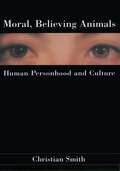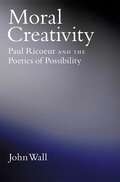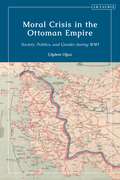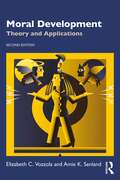- Table View
- List View
Moonpaths: Ethics and Emptiness
by The CowherdsThe Mahayana tradition in Buddhist philosophy is defined by its ethical orientation--the adoption of bodhicitta, the aspiration to attain awakening for the benefit of all sentient beings. And indeed, this tradition is known for its literature on ethics, which reflect the Madhyamaka tradition of philosophy, and emphasizes both the imperative to cultivate an attitude of universal care (karuna) grounded in the realization of emptiness, impermanence, independence, and the absence of any self in persons or other phenomena.This position is morally very attractive, but raises an important problem: if all phenomena, including persons and actions, are only conventionally real, can moral injunctions or principles be binding, or does the conventional status of the reality we inhabit condemn us to an ethical relativism or nihilism? In Moonpaths, the Cowherds address an analogous problem in the domain of epistemology and argues that the Madhyamaka tradition has the resources to develop a robust account of truth and knowledge within the context of conventional reality. The essays explore a variety of ways in which to understand important Buddhist texts on ethics and Mahayana moral theory so as to make sense of the genuine force of morality.
Moonpaths: Ethics and Emptiness
by The CowherdsThe Mahayana tradition in Buddhist philosophy is defined by its ethical orientation--the adoption of bodhicitta, the aspiration to attain awakening for the benefit of all sentient beings. And indeed, this tradition is known for its literature on ethics, which reflect the Madhyamaka tradition of philosophy, and emphasizes both the imperative to cultivate an attitude of universal care (karuna) grounded in the realization of emptiness, impermanence, independence, and the absence of any self in persons or other phenomena.This position is morally very attractive, but raises an important problem: if all phenomena, including persons and actions, are only conventionally real, can moral injunctions or principles be binding, or does the conventional status of the reality we inhabit condemn us to an ethical relativism or nihilism? In Moonpaths, the Cowherds address an analogous problem in the domain of epistemology and argues that the Madhyamaka tradition has the resources to develop a robust account of truth and knowledge within the context of conventional reality. The essays explore a variety of ways in which to understand important Buddhist texts on ethics and Mahayana moral theory so as to make sense of the genuine force of morality.
Moonshadows: Conventional Truth in Buddhist Philosophy
by The CowherdsThe doctrine of the two truths--a conventional truth and an ultimate truth--is central to Buddhist metaphysics and epistemology. The two truths (or two realities), the distinction between them, and the relation between them is understood variously in different Buddhist schools and is of special importance to the Madhyamaka school. The fundamental ideas are articulated with particular force by Nagarjuna (2nd--3rd century CE) who famously claims that the two truths are identical to one another, and yet distinct. One of the most influential interpretations of Nagarjuna's difficult doctrine derives from the commentary of Candrakirti (6th century CE). While much attention has been devoted to explaining the nature of the ultimate truth in view of its special soteriological role, less has been paid to understanding the nature of conventional truth, which is often described as "deceptive," "illusion," or "truth for fools." But conventional truth is nonetheless truth. This book therefore asks, "what is true about conventional truth?" and "What are the implications of an understanding of conventional truth for our lives?"
Moonshadows: Conventional Truth in Buddhist Philosophy
by The CowherdsThe doctrine of the two truths--a conventional truth and an ultimate truth--is central to Buddhist metaphysics and epistemology. The two truths (or two realities), the distinction between them, and the relation between them is understood variously in different Buddhist schools and is of special importance to the Madhyamaka school. The fundamental ideas are articulated with particular force by Nagarjuna (2nd--3rd century CE) who famously claims that the two truths are identical to one another, and yet distinct. One of the most influential interpretations of Nagarjuna's difficult doctrine derives from the commentary of Candrakirti (6th century CE). While much attention has been devoted to explaining the nature of the ultimate truth in view of its special soteriological role, less has been paid to understanding the nature of conventional truth, which is often described as "deceptive," "illusion," or "truth for fools." But conventional truth is nonetheless truth. This book therefore asks, "what is true about conventional truth?" and "What are the implications of an understanding of conventional truth for our lives?"
Moore's Introduction to English Canon Law: Fourth Edition
by Timothy BridenThis fourth revised edition brings an invaluable text thoroughly up to date in light of recent and forthcoming changes to ecclesiastical law. Theological students and clergy need to know the canon law in which much of their theology and parish work is embedded. Practising lawyers will find here information on the immediate problems arising in ecclesiastical cases as well as the background of ecclesiastical law in which they are set. This book deals with the basic principles on which canon law is built and with the complications which arise by reason of the Establishment, and gives in outline the constitution of the Church of England, and the law relating to its worship, sacraments, property, and persons.
Moore's Introduction to English Canon Law: Fourth Edition
by Timothy BridenThis fourth revised edition brings an invaluable text thoroughly up to date in light of recent and forthcoming changes to ecclesiastical law. Theological students and clergy need to know the canon law in which much of their theology and parish work is embedded. Practising lawyers will find here information on the immediate problems arising in ecclesiastical cases as well as the background of ecclesiastical law in which they are set. This book deals with the basic principles on which canon law is built and with the complications which arise by reason of the Establishment, and gives in outline the constitution of the Church of England, and the law relating to its worship, sacraments, property, and persons.
The Moot Papers: Faith, Freedom and Society 1938-1944
by Keith ClementsThe Moot was the study and discussion group set up by J.H. Oldham (1874-1969) following the 1937 Oxford Conference on "Church, Community and State." Its purpose was to continue, in an informal, confidential but serious way, exploration of the relation between church and society and the realisation of Christian ethics in the public sphere. The Moot met twice or three times a year from 1938 to 1947 (21 times in all) and was convened by Oldham with the conscious intention of responding to the grave crisis that was felt to be facing western society in Britain no less than on the continent of Europe. Overall some 35 people attended the Moot at one time or another, but its core comprised a small number of regular members who were representative of the highest levels in theology, social science and public affairs. In addition to Oldham himself they included John Baillie, T.S. Eliot, H.A. Hodges, Eleonora Iredale, Adolf Löwe, Karl Mannheim, Walter Moberly, John Middleton Murry and Alec Vidler. Other participants included Kathleen Bliss, Fred Clarke, Christopher Dawson, H.H. Farmer, Hector Hetherington, Walter Oakshott and Gilbert Shaw, while notables such as Reinhold Niebuhr, Melville Chaning-Pearce, Donald Mackinnon, Philip Mairet, Lesslie Newbigin, William Paton, Frank Pakenham (later Lord Longford), Michael Polanyi and Oliver Tomkins made occasional "guest appearances." Against the background of impending and then actual war, the discussions in the Moot repeatedly focused on the "planned" nature of modern society and therewith the roles (if any) within it of moral choice and the Christian community.
The Moot Papers: Faith, Freedom and Society 1938-1944
by Keith ClementsThe Moot was the study and discussion group set by J.H. Oldham (1874-1969) following the 1937 Oxford conference on "Church, Community and State". Its purpose was to continue, in an informal but serious way, exploration of the relation between church and society and the realization of Christian ethics in the public sphere. The Moot met twice or three times a year from 1938 to 1947 (21 times in all) and was convened by Oldham with the conscious intention of responding to the grave crisis that was felt to be facing western society in Britain no less than on the continent of Europe. Overall some 35 people attended the Moot at one time or another, but its core comprised a small number of regular members who were representative of the highest levels in theology, social science and public affairs. In addition to Oldham himself they included T.S. Elliot, H. A. Hodges, Eleonora Iredale, Adolf Löwe, Karl Mannheim, Walter Moberly, John Middleton Murry and Alec Vidler. Other participants included Kathleen Bliss, Fred Clarke, Christopher Dawson, H. H. Farmer, Hector Hetherington, Walter Oakshott and Gilbert Shaw, while notables such as Reinhold Niebuhr, Melville Chaning-Pearce, Donald McKinnon, Philip Mairet, Leslie Newbiggin, William Paton, Frank Pakenham (later Lord Longford), Michael Polanyi and Oliver Tomkins made occasional "guest appearances". Against the background of impending and then actual war, the discussions in the Moot repeatedly focused on the "planned" nature of modern society and therewith the roles (if any) within it of moral choice and the Christian community.
Moral Agents and Their Deserts: The Character of Mu'tazilite Ethics
by Sophia VasalouMust good deeds be rewarded and wrongdoers punished? Would God be unjust if He failed to punish and reward? And what is it about good or evil actions and moral identity that might generate such necessities? These were some of the vital religious and philosophical questions that eighth- and ninth-century Mu'tazilite theologians and their sophisticated successors attempted to answer, giving rise to a distinctive ethical position and one of the most prominent and controversial intellectual trends in medieval Islam. The Mu'tazilites developed a view of ethics whose distinguishing features were its austere moral objectivism and the crucial role it assigned to reason in the knowledge of moral truths. Central to this ethical vision was the notion of moral desert, and of the good and evil consequences--reward or punishment--deserved through a person's acts. Moral Agents and Their Deserts is the first book-length study of this central theme in Mu'tazilite ethics, and an attempt to grapple with the philosophical questions it raises. At the same time, it is a bid to question the ways in which modern readers, coming to medieval Islamic thought with a philosophical interest, seek to read and converse with Mu'tazilite theology. Moral Agents and Their Deserts tracks the challenges and rewards involved in the pursuit of the right conversation at the seams between modern and medieval concerns.
Moral and Spiritual Leadership in an Age of Plural Moralities (Studies in World Christianity and Interreligious Relations)
by Ina Ter Avest Hans AlmaIn crisis situations, such as terror attacks or societal tensions caused by migration, people tend to look for explicit moral and spiritual leadership and are often inclined to vote for so-called 'strong leaders'. Is there a way to resist the temptation of the simplistic solutions that these ‘strong leader’ offer, and instead encourage constructive engagement with the complex demands of our times? This volume utilises relational and dialogical perspectives to examine and address many of the issues surrounding the moral and spiritual guidance articulated in globalizing Western societies. The essays in this collection focus on the concept of plural moralities, understood as divergent visions on what is a 'good life', both in an ethical, aesthetical, existential, and spiritual sense. They explore the political-cultural context and consequences of plural moralities as well as discussing challenges, possibilities, risks, and dangers from the perspective of two promising relational theories: social constructionism and dialogical self theory. The overarching argument is that it is possible to constructively put in nuanced moral and spiritual guidance into complex, plural societies. By choosing a clear theoretical focus on relational approaches to societal challenges, this interdisciplinary book provides both a broad scope and a coherent argument. It will be of great interest to scholars of social and political psychology, leadership and organization, religious studies, and pedagogy.
Moral and Spiritual Leadership in an Age of Plural Moralities (Studies in World Christianity and Interreligious Relations)
by Ina Ter Avest Hans AlmaIn crisis situations, such as terror attacks or societal tensions caused by migration, people tend to look for explicit moral and spiritual leadership and are often inclined to vote for so-called 'strong leaders'. Is there a way to resist the temptation of the simplistic solutions that these ‘strong leader’ offer, and instead encourage constructive engagement with the complex demands of our times? This volume utilises relational and dialogical perspectives to examine and address many of the issues surrounding the moral and spiritual guidance articulated in globalizing Western societies. The essays in this collection focus on the concept of plural moralities, understood as divergent visions on what is a 'good life', both in an ethical, aesthetical, existential, and spiritual sense. They explore the political-cultural context and consequences of plural moralities as well as discussing challenges, possibilities, risks, and dangers from the perspective of two promising relational theories: social constructionism and dialogical self theory. The overarching argument is that it is possible to constructively put in nuanced moral and spiritual guidance into complex, plural societies. By choosing a clear theoretical focus on relational approaches to societal challenges, this interdisciplinary book provides both a broad scope and a coherent argument. It will be of great interest to scholars of social and political psychology, leadership and organization, religious studies, and pedagogy.
The Moral Argument: A History
by David Baggett Jerry WallsThe history of the moral argument for the existence of God is a fascinating tale. Like any good story, it is full of twists and unexpected turns, compelling conflicts, memorable and idiosyncratic characters, both central and ancillary players. The narrative is as labyrinthine and circuitous as it is linear, its point yet to be fully seen, and its ending yet to be written. What remains certain is the importance of telling it. The resources of history offer a refresher course, a teachable moment, a cautionary tale about the need to avoid making sacrosanct the trends of the times, and an often sobering lesson in why reigning assumptions may need to be rejected. This book lets the argument's advocates, many long dead, come alive again and speak for themselves. A historical study of the moral argument is a reminder that classical philosophers were unafraid to ask and explore the big questions of faith, hope, and love; of truth, goodness, and beauty; of God, freedom, and immortality. It gives students and scholars alike the chance to drill down into their ideas, contexts, and arguments. Only by a careful study of its history can we come to see its richness and the range of resources it offers.
MORAL ARGUMENT C: A History
by David Baggett Jerry WallsThe history of the moral argument for the existence of God is a fascinating tale. Like any good story, it is full of twists and unexpected turns, compelling conflicts, memorable and idiosyncratic characters, both central and ancillary players. The narrative is as labyrinthine and circuitous as it is linear, its point yet to be fully seen, and its ending yet to be written. What remains certain is the importance of telling it. The resources of history offer a refresher course, a teachable moment, a cautionary tale about the need to avoid making sacrosanct the trends of the times, and an often sobering lesson in why reigning assumptions may need to be rejected. This book lets the argument's advocates, many long dead, come alive again and speak for themselves. A historical study of the moral argument is a reminder that classical philosophers were unafraid to ask and explore the big questions of faith, hope, and love; of truth, goodness, and beauty; of God, freedom, and immortality. It gives students and scholars alike the chance to drill down into their ideas, contexts, and arguments. Only by a careful study of its history can we come to see its richness and the range of resources it offers.
Moral, Believing Animals: Human Personhood and Culture
by Christian SmithWhat kind of animals are human beings? And how do our visions of the human shape our theories of social action and institutions? In Moral, Believing Animals, Christian Smith advances a creative theory of human persons and culture that offers innovative, challenging answers to these and other fundamental questions in sociological, cultural, and religious theory. Smith suggests that human beings have a peculiar set of capacities and proclivities that distinguishes them significantly from other animals on this planet. Despite the vast differences in humanity between cultures and across history, no matter how differently people narrate their lives and histories, there remains an underlying structure of human personhood that helps to order human culture, history, and narration. Drawing on important recent insights in moral philosophy, epistemology, and narrative studies, Smith argues that humans are animals who have an inescapable moral and spiritual dimension. They cannot avoid a fundamental moral orientation in life and this, says Smith, has profound consequences for how sociology must study human beings.
Moral, Believing Animals: Human Personhood and Culture
by Christian SmithWhat kind of animals are human beings? And how do our visions of the human shape our theories of social action and institutions? In Moral, Believing Animals, Christian Smith advances a creative theory of human persons and culture that offers innovative, challenging answers to these and other fundamental questions in sociological, cultural, and religious theory. Smith suggests that human beings have a peculiar set of capacities and proclivities that distinguishes them significantly from other animals on this planet. Despite the vast differences in humanity between cultures and across history, no matter how differently people narrate their lives and histories, there remains an underlying structure of human personhood that helps to order human culture, history, and narration. Drawing on important recent insights in moral philosophy, epistemology, and narrative studies, Smith argues that humans are animals who have an inescapable moral and spiritual dimension. They cannot avoid a fundamental moral orientation in life and this, says Smith, has profound consequences for how sociology must study human beings.
Moral Combat: How Sex Divided American Christians and Fractured American Politics
by R. Marie GriffithFrom an esteemed scholar of American religion and sexuality, a sweeping account of the century of religious conflict that produced our culture wars Gay marriage, transgender rights, birth control--sex is at the heart of many of the most divisive political issues of our age. The origins of these conflicts, historian R. Marie Griffith argues, lie in sharp disagreements that emerged among American Christians a century ago. From the 1920s onward, a once-solid Christian consensus regarding gender roles and sexual morality began to crumble, as liberal Protestants sparred with fundamentalists and Catholics over questions of obscenity, sex education, and abortion. Both those who advocated for greater openness in sexual matters and those who resisted new sexual norms turned to politics to pursue their moral visions for the nation. Moral Combat is a history of how the Christian consensus on sex unraveled, and how this unraveling has made our political battles over sex so ferocious and so intractable.
Moral Commerce: Quakers and the Transatlantic Boycott of the Slave Labor Economy
by Julie L. HolcombHow can the simple choice of a men’s suit be a moral statement and a political act? When the suit is made of free-labor wool rather than slave-grown cotton. In Moral Commerce, Julie L. Holcomb traces the genealogy of the boycott of slave labor from its seventeenth-century Quaker origins through its late nineteenth-century decline. In their failures and in their successes, in their resilience and their persistence, antislavery consumers help us understand the possibilities and the limitations of moral commerce. Quaker antislavery rhetoric began with protests against the slave trade before expanding to include boycotts of the use and products of slave labor. For more than one hundred years, British and American abolitionists highlighted consumers’ complicity in sustaining slavery. The boycott of slave labor was the first consumer movement to transcend the boundaries of nation, gender, and race in an effort by reformers to change the conditions of production. The movement attracted a broad cross-section of abolitionists: conservative and radical, Quaker and non-Quaker, male and female, white and black. The men and women who boycotted slave labor created diverse, biracial networks that worked to reorganize the transatlantic economy on an ethical basis. Even when they acted locally, supporters embraced a global vision, mobilizing the boycott as a powerful force that could transform the marketplace. For supporters of the boycott, the abolition of slavery was a step toward a broader goal of a just and humane economy. The boycott failed to overcome the power structures that kept slave labor in place; nonetheless, the movement’s historic successes and failures have important implications for modern consumers.
Moral Creativity: Paul Ricoeur and the Poetics of Possibility (AAR Reflection and Theory in the Study of Religion)
by John WallIn Moral Creativity, John Wall argues that moral life and thought are inherently and radically creative. Human beings are called by their own primordially created depths to exceed historical evil and tragedy through the ongoing creative transformation of their world. This thesis challenges ancient Greek and biblical separations of ethics and poetic image-making, as well as contemporary conceptions of moral life as grounded in abstract principles or preconstituted traditions. Taking as his point of departure the poetics of the will of Paul Ricoeur, and ranging widely into critical conversations with Continental, narrative, feminist, and liberationist ethics, Wall uncovers the profound senses in which moral practice and thought involve tension, catharsis, excess, and renewal. In the process, he draws new connections between sin and tragedy, practice and poetics, and morality and myth. Rather than proposing a complete ethics, Moral Creativity is a meta-ethical work investigating the creative capability as part of what it means, morally, to be human. This capability is explored around four dimensions of ontology, teleology, deontology, and social practice. In each case, Wall examines a traditional perspective on the relation of ethics to poetics, critiques it using resources from contemporary phenomenology, and develops a conception of a more original poetics of moral life. In the end, moral creativity is a human capability for inhabiting tensions among others and in social systems and, in the image of a Creator, creating together an ever more radically inclusive moral world.
Moral Crisis in the Ottoman Empire: Society, Politics, and Gender during WWI
by Çigdem OguzTo what extent did a perceived morality crisis play a role in the dramatic events of the last years of the Ottoman Empire? Beginning in the late nineteenth century when some of the Ottoman elites began to question the moral climate as evidence for the losses facing the empire, this book shows that during the course of World War I many social, economic, and political problems were translated into a discourse of moral decline, ultimately making morality a contested space between rival ideologies, identities, and intellectual currents. Examining the primary journals and printed sources that represented the various constituencies of the period, it fills important gaps in the scholarship of the Ottoman experience of World War I and the origins of Islamism and secularism in Turkey, and is essential reading for social and intellectual historians of the late Ottoman Empire.
Moral Crisis in the Ottoman Empire: Society, Politics, and Gender during WWI
by Çigdem OguzTo what extent did a perceived morality crisis play a role in the dramatic events of the last years of the Ottoman Empire? Beginning in the late nineteenth century when some of the Ottoman elites began to question the moral climate as evidence for the losses facing the empire, this book shows that during the course of World War I many social, economic, and political problems were translated into a discourse of moral decline, ultimately making morality a contested space between rival ideologies, identities, and intellectual currents. Examining the primary journals and printed sources that represented the various constituencies of the period, it fills important gaps in the scholarship of the Ottoman experience of World War I and the origins of Islamism and secularism in Turkey, and is essential reading for social and intellectual historians of the late Ottoman Empire.
Moral Crusades in an Age of Mistrust: The Jimmy Savile Scandal
by F. FurediThe epidemic of scandals unleashed by the Savile Scandal highlights the precarious status of relations of trust. The rapid escalation of this crisis offers insights into the relationship between anxieties about childhood and the wider moral order. This book explains why western society has become so uncomfortable with the exercise of authority.
The Moral Culture of the Scottish Enlightenment: 1690–1805 (The Lewis Walpole Series in Eighteenth-Century Culture and History)
by Thomas AhnertIn the Enlightenment it was often argued that moral conduct, rather than adherence to theological doctrine, was the true measure of religious belief. Thomas Ahnert argues that this “enlightened” emphasis on conduct in religion relied less on arguments from reason alone than has been believed. In fact, Scottish Enlightenment champions advocated a practical program of “moral culture,” in which revealed religion was of central importance. Ahnert traces this to theological controversies going back as far as the Reformation concerning the conditions of salvation. His findings present a new point of departure for all scholars interested in the intersection of religion and Enlightenment.
Moral Development: Theory and Applications
by Elizabeth C. VozzolaA CHOICE Outstanding Academic Title 2014! This class-tested text provides a comprehensive overview of the classical and current theories of moral development and applications of these theories in various counseling and educational settings. Lively and accessible, this text engages students through numerous examples and boxes that highlight applications of moral development concepts in today’s media and/or interviews from some of today’s leading theorists or practitioners. Dilemma of the Day boxes help readers apply theory to real world situations. Each chapter concludes with discussion questions and further resources. Summary tables of theory strengths and weaknesses (Part 1) and tables that connect applications to their theoretical roots are provided in Part 2. Other highlights include: Provides an excellent resource for courses addressing the CACREP program objectives for Human Growth and Development. Emphasis on application helps readers make the connection between theory and moral issues of our time. Examines changes across time and experience in how people understand right and wrong and individual differences in moral judgments, emotions, and actions. Demonstrates how theory is used by today‘s helping professionals (Part 1). Integrates issues of gender and ethnicity throughout to prepare readers for practicing in a global culture. Chapter on global perspectives (ch. 6) reviews theories on the cultural aspects of morality including examples from China, Islam, Latin America, and Africa. Reviews the latest research methods techniques used in the field. Integrates classic work with contemporary guidelines for assessment and treatment. Highlights research on the moral and empathic development of antisocial youth, psychopaths, and individuals diagnosed on the Autism Spectrum. Each chapter in Part 1 provides a comprehensive overview of the theory under review, its strengths and challenges, and examples of how the theory applies to helping professionals. The theories covered include those by Freud, Piaget, Kohlberg, Rest, Gilligan, Nodding, Bandura, Turiel, Nucci, Haidt, and Shweder. Part 1 concludes with a summary of the key points and the strengths and weaknesses of each of the theories reviewed. Part 2 highlights promising applications of moral development theory in education and counseling. These include coverage of character education programs based on sound developmental theory and examples of how drawing on a deep grounding in moral development theory can help future counselors better evaluate their clients’ cognitive, emotional and behavioral challenges. The text explores specific approaches to helping clients with a variety of dysfunctional or developmental behavior problems like conduct disorder and psychopathy. Ideal as a text for advanced undergraduate and/or graduate courses on moral development or moral psychology or as a supplement in courses on human and/or child and/or social and personality development taught in psychology, counseling, education, human development, family studies, social work, and religion, this book’s applied approach also appeals to mental health and school counselors.
Moral Development: Theory and Applications
by Elizabeth C. VozzolaA CHOICE Outstanding Academic Title 2014! This class-tested text provides a comprehensive overview of the classical and current theories of moral development and applications of these theories in various counseling and educational settings. Lively and accessible, this text engages students through numerous examples and boxes that highlight applications of moral development concepts in today’s media and/or interviews from some of today’s leading theorists or practitioners. Dilemma of the Day boxes help readers apply theory to real world situations. Each chapter concludes with discussion questions and further resources. Summary tables of theory strengths and weaknesses (Part 1) and tables that connect applications to their theoretical roots are provided in Part 2. Other highlights include: Provides an excellent resource for courses addressing the CACREP program objectives for Human Growth and Development. Emphasis on application helps readers make the connection between theory and moral issues of our time. Examines changes across time and experience in how people understand right and wrong and individual differences in moral judgments, emotions, and actions. Demonstrates how theory is used by today‘s helping professionals (Part 1). Integrates issues of gender and ethnicity throughout to prepare readers for practicing in a global culture. Chapter on global perspectives (ch. 6) reviews theories on the cultural aspects of morality including examples from China, Islam, Latin America, and Africa. Reviews the latest research methods techniques used in the field. Integrates classic work with contemporary guidelines for assessment and treatment. Highlights research on the moral and empathic development of antisocial youth, psychopaths, and individuals diagnosed on the Autism Spectrum. Each chapter in Part 1 provides a comprehensive overview of the theory under review, its strengths and challenges, and examples of how the theory applies to helping professionals. The theories covered include those by Freud, Piaget, Kohlberg, Rest, Gilligan, Nodding, Bandura, Turiel, Nucci, Haidt, and Shweder. Part 1 concludes with a summary of the key points and the strengths and weaknesses of each of the theories reviewed. Part 2 highlights promising applications of moral development theory in education and counseling. These include coverage of character education programs based on sound developmental theory and examples of how drawing on a deep grounding in moral development theory can help future counselors better evaluate their clients’ cognitive, emotional and behavioral challenges. The text explores specific approaches to helping clients with a variety of dysfunctional or developmental behavior problems like conduct disorder and psychopathy. Ideal as a text for advanced undergraduate and/or graduate courses on moral development or moral psychology or as a supplement in courses on human and/or child and/or social and personality development taught in psychology, counseling, education, human development, family studies, social work, and religion, this book’s applied approach also appeals to mental health and school counselors.
Moral Development: Theory and Applications
by Elizabeth C. Vozzola Amie K. SenlandMoral Development offers a comprehensive overview of classic and current theories of moral development and applications of these theories in various counseling and educational settings. It examines changes across time and experience in how people understand right and wrong, and individual differences in moral judgements, emotions, and actions. Elizabeth C. Vozzola and Amie K. Senland review the latest research in the field and integrate classic work with contemporary perspectives on assessment and treatment. Part 1 provides an understanding of a range of theories, explaining their strengths and challenges, and offering examples of how these theories apply to helping professionals. It covers Freud, Piaget, Kohlberg, Rest, Gilligan, Nodding, Bandura, Turiel, Nucci, Narvaez, Haidt, and Shweder. Part 2 highlights promising applications of moral development theory in education and counseling. Fully updated with new chapters on faith development and moral and prosocial development in infancy and early childhood, the text explores specific approaches to helping clients with a variety of clinical or developmental challenges and provides an excellent resource for courses addressing the CACREP program objectives for Human Growth and Development. It also integrates issues of gender, ethnicity, and culture throughout to prepare readers for practicing in a global culture and presents a new perspective: the cultural developmental approach. Illustrated throughout with examples that highlight applications of moral development concepts in today’s media, it also includes interviews from some of today’s leading theorists and practitioners. Ideal as a text for advanced courses on moral development and moral psychology, as well as courses on human, child, social and personality development taught in psychology, counseling, education, human development, family studies, social work, and religion. Its applied approach also appeals to mental health and school counselors.

















